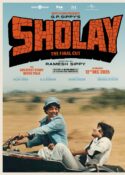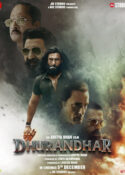 We have seen his stories and experiences working with children told through the beautiful film Taare Zameen Par, and now Amole Gupte is sharing more with us in his directorial debut, Stanley Ka Dabba. Based on a script that Mr. Gupte wrote in 2008, this film was not made in the standard way, with filming schedules, long hours of shooting, big crews, etc.. In fact, it was developed and filmed over a year and half during sessions of children’s arts classes that Mr. Gupte was holding at a school on Saturdays. The story of Stanley Ka Dabba is an inspirational and an emotional drama about children and their tiffin box. The movie throws light on the everyday life of a schoolchild and revolves around the protagonist Stanley, his friends, and how he rises against all odds. But more on that later; I got the chance to talk to the director about this unique film and had a fascinating conversation about working with children, the development of the film, and what makes Stanley Ka Dabba so special.
We have seen his stories and experiences working with children told through the beautiful film Taare Zameen Par, and now Amole Gupte is sharing more with us in his directorial debut, Stanley Ka Dabba. Based on a script that Mr. Gupte wrote in 2008, this film was not made in the standard way, with filming schedules, long hours of shooting, big crews, etc.. In fact, it was developed and filmed over a year and half during sessions of children’s arts classes that Mr. Gupte was holding at a school on Saturdays. The story of Stanley Ka Dabba is an inspirational and an emotional drama about children and their tiffin box. The movie throws light on the everyday life of a schoolchild and revolves around the protagonist Stanley, his friends, and how he rises against all odds. But more on that later; I got the chance to talk to the director about this unique film and had a fascinating conversation about working with children, the development of the film, and what makes Stanley Ka Dabba so special.
One of the things Mr. Gupte is very passionate about is that children need exposure to the Arts, be it cinema, music, dance, theater and art. “For some years, I’ve been doing theatre and cinema and art sessions in schools. I wouldn’t call it a workshop, because there is no work done there and neither is it a shop. Children need to be sensitized to the arts, which unfortunately does not happen in my nation. In fact, the arts have been put out of the system after 8th standard, the 8th grade, so it’s a clear signal by the system to the parents and the educational institution that arts are not important after 8th grade. You know, start crunching your numbers and start doing physics and some other shit. That’s the end of your child’s life and his creativity, ALL his creativity. That distress is seen on the children’s faces but adults rarely notice it.” So, to combat and counteract this, Mr. Gupte has been holding special arts classes for the past 10 years, working all over with children at schools from all walks of life, working with children with disabilities, (remember that beautiful scene in TZP), so they can experience the magic and the creativity that the Arts can bring.
 It was within one of these special sessions that he decided to make Stanley Ka Dabba. “I opened a voluntary session class on Saturdays in this particular school for its children for four hours. I never promised a film to myself, but one happened. As we went along I thought, let me session this one screenplay I had with this class. So, we kind of built it up over 11/2 years and at the end of this period we had a film in hand called Stanley Ka Dabba (Stanley’s Lunch Box).”
It was within one of these special sessions that he decided to make Stanley Ka Dabba. “I opened a voluntary session class on Saturdays in this particular school for its children for four hours. I never promised a film to myself, but one happened. As we went along I thought, let me session this one screenplay I had with this class. So, we kind of built it up over 11/2 years and at the end of this period we had a film in hand called Stanley Ka Dabba (Stanley’s Lunch Box).”
The whole film was a process of exposing the children to filmmaking and having fun at the same time. Since the development was unique, he also presented the script to the children in a cool way. He did not just give pages and pages to the children to learn their lines and get ready for filming; instead it was done through talking and discussing the scenes and lines. “I made it like an oral tradition, you know, like the Mahabharata. How do we know the Mahabharata? It is oral tradition. How do we know the sloks and all the Sanskrit that we know? It is passed on from generation to generation without a piece of paper exchanging hands. So, I think that’s the best practice if one wants to be with children. Do not put a paper in front of them and tell them to mug, otherwise it won’t be any different from Monday to Friday, which is their regular school day, and they have to do only that. It’s liberating when you sit down together and discuss a scene, which is already pre-written, but done this way it makes the children feel as if it came out from their mouth. Then they own it. So, that becomes very pristine and very virgin in terms of that instinct of that moment in cinema.”
It was important to Mr. Gupte that the sessions were only four hours long (with breaks) and only on Saturdays. That is completely opposite to how children usually work in films. “We have no rules in India about filming children; if you have a shot of an animal in your film then it’s mandatory to have a board saying that there was a human being there supervising the shoot: whether you are doing it all right, whether there’s cruelty on set and all that. But for children there is nobody. In fact, there are parents who are cash cowing the children and they are doing 12, sometime 14-15 hours a day. Their day finishes at 4 in the morning and they are losing school. Here there were 500 children in this film and not a single child lost a single minute of school in these 11/2 years. We met up on Saturdays and not even Sundays because children should be with their parents. The session had 2 breaks, 2 recesses. One recess they were to bring their boxes and the 2nd recess I would give them a box to eat.
 “So, I”m just trying to put my money where my mouth is. Instead of being judgmental of what other people are doing I decided, let me just do it in this form and if it happens then it can be followed. Then people cannot say ‘Oh, this is not possible, it is logistically not possible’ then there is an answer that would be ‘No, no, no Amole Gupte has done, so you can do it’.”
“So, I”m just trying to put my money where my mouth is. Instead of being judgmental of what other people are doing I decided, let me just do it in this form and if it happens then it can be followed. Then people cannot say ‘Oh, this is not possible, it is logistically not possible’ then there is an answer that would be ‘No, no, no Amole Gupte has done, so you can do it’.”
The crew had to work differently as well. “We did not invest in lights because we shot fabulously digitally. I dare any DOP or filmmaker to test the quality and the result of this 35 mm film. It was just me and four or five assistants and my DOP and that’s the unit. We don’t have spot boys and production managers and ADs and 2nd ADs and 4th ADs. It’s just a five-member unit, which is moving around in this school on Saturdays, and that’s it.”
Adding, “It was very non-intrusive. The children kind of came to life, they are in their own kingdom… they are the kings of their place. They brought to life my Stanley Ka Dabba screenplay with their own interpretations. I think it’s a one of its kind, perhaps for the first time in the world for a feature film.”
Playing the lead character is his son Partho. Mr. Gupte says that because Partho has studied and been part of the sessions he really was able to become Stanley. “Yes, because he understands. The boy who’s playing Stanley… Partho has been, since the age of three, sensitized to the range of children who have been part of my sessions over the last 10 years. About three or four years into it Partho began participating with children with varying abilities, children with physical and mental challenges, children with financial challenges from the margin life section so he’s kind of sensitized to number 1, the sociology of our nation and 2, he is sensitized to portrayal, because he’s seen a lot of cinema sessions. He’s aware of the entire rainbow of Iranian cinema, he’s aware of Chaplin, Buster Keaton and the Marx Brothers. Those are some of his inspirations and therefore he’s quite a studied little actor.”
 Looking back over the whole process to the final product, did it end up to be what he thought it would be? Answering very thoughtfully he said, “It grew like a tree. It is very, very Zen. When you look at it’s beauty, you can easily distance yourself from this beauty and say ‘Oh, this also God created and you’re the instrument.’ There is a certain beauty about its natural tone and fiber. Then you cannot own it; you can’t claim it’s yours. It belongs to the children, it belongs to the process and definitely you feel like a mighty happy father. But definitely it’s the karma of the process.”
Looking back over the whole process to the final product, did it end up to be what he thought it would be? Answering very thoughtfully he said, “It grew like a tree. It is very, very Zen. When you look at it’s beauty, you can easily distance yourself from this beauty and say ‘Oh, this also God created and you’re the instrument.’ There is a certain beauty about its natural tone and fiber. Then you cannot own it; you can’t claim it’s yours. It belongs to the children, it belongs to the process and definitely you feel like a mighty happy father. But definitely it’s the karma of the process.”
The reaction of the kids once they saw the final product? “(Laughs) They were so happy about it. They came in with their parents and they were gloating. That’s a nice feeling. I didn’t promise them a film. This becomes a huge bonus for them. Finally, not just what we did there gave us pleasure, but it’s going to go out there and give other people pleasure!”
In closing, he says what audiences will love about Stanley Ka Dabba, along with the way the film was made, is the spirit of the little boy Stanley, “The audiences could possibly love the spirit of the boy and the spirit of his friends, the bonding that they share. Stanley and his friends Abhishek and Aman; there are about seven friends who stand up for him. That kind of bonding – they are going to celebrate the human spirit that is so kindled in children.”
Here is that bit more on the story of the film that I promised.
Synopsis: Imagine this boy in your mind’s eye. He arrives in school long before any of his classmates to drum away his blues on empty benches. He stuffs himself with water instead of the nutritious food that his schoolmates relish during the lunch break. He covers up for his lack of social rank with the finesse of the most seasoned diplomat.
Who is this child? What is he like? Why is he anything like he is? Wouldn’t you like to know? Meet Stanley, the protagonist of the much awaited Stanley Ka Dabba.









